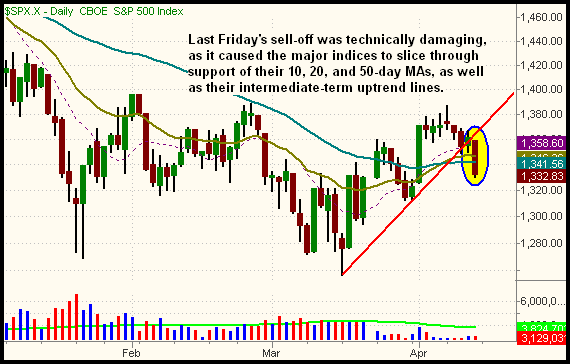| The Wagner Daily ETF Report for April 14 |
| By Deron Wagner |
Published
04/14/2008
|
Stocks
|
Unrated
|
|
|
|
The Wagner Daily ETF Report for April 14
 A rare miss in the quarterly earnings report of General Electric (GE) spooked the market last Friday morning, triggering a broad-based sell-off that damaged the charts of the major indices. Stocks gapped lower on the open, traded in a tight, sideways range throughout the morning, then continued lower in the afternoon. Both the S&P 500 and Dow Jones Industrial Average fell 2.0%, while the Nasdaq Composite tumbled 2.6%. The small-cap Russell 2000 similarly lost 2.7%, but the S&P Midcap 400 continued to show slight relative strength by shedding "only" 1.8%. The main stock market indexes finished at their intraday lows, as well as their lowest levels of the week. A rare miss in the quarterly earnings report of General Electric (GE) spooked the market last Friday morning, triggering a broad-based sell-off that damaged the charts of the major indices. Stocks gapped lower on the open, traded in a tight, sideways range throughout the morning, then continued lower in the afternoon. Both the S&P 500 and Dow Jones Industrial Average fell 2.0%, while the Nasdaq Composite tumbled 2.6%. The small-cap Russell 2000 similarly lost 2.7%, but the S&P Midcap 400 continued to show slight relative strength by shedding "only" 1.8%. The main stock market indexes finished at their intraday lows, as well as their lowest levels of the week.
The only encouraging facet of last Friday's decline was that the losses occurred on slightly lower turnover. Total volume in the NYSE declined 4%, as volume in the Nasdaq registered 14% below the previous day's level. Higher trading activity would have pointed to bearish institutional selling, but surprisingly that wasn't the case. Still, market internals were not pretty. In the NYSE, declining volume trounced advancing volume by a margin of nearly 10 to 1. The Nasdaq adv/dec volume ratio was negative by more than 6 to 1.
We viewed last Thursday's rally as a technically significant session. After retracing gains from its April 1 breakout throughout the preceding week and a half, the broad market should have followed through on Thursday's gains, paving the way for stocks to cruise to new near-term highs. Instead, the poor pre-market numbers of behemoth conglomerate General Electric ignited fears that corporate earnings reports may be less than impressive this time around. When the major indices opened below Thursday's lows and failed to quickly reverse, that was a bad sign for the intermediate-term uptrends that had just begun to develop. Further, a lot of technical damage has been done. For starters, the S&P, Nasdaq, and Dow each dropped back below support of their 50-day moving averages. Unless the market snaps back today and shows last Friday's sell-off was just a shakeout, the break of the 50-day moving averages is a bearish signal.
In the April 10 issue of The Wagner Daily, we illustrated how the S&P 500 had come into support of both its 10-day moving average and newly developed intermediate-term uptrend line. This confluence of support "did its thing" by enabling the S&P to move higher the following day, but last Friday's selloff caused the index to fall below its 10, 20, and 50-day moving averages, as well as its uptrend line that began with the March low. This bearish change of momentum is shown on the daily chart of the S&P 500 below:
Although the S&P raced 3.6% higher on April 1, notice that the index has already given back most of that day's gain. The same is true of the Dow and Nasdaq. With the major indices having surrendered more than two-thirds of their gains from the March 31 lows to April 8 highs, our near-term bias has now shifted to bearish. Our intermediate-term bias has changed from bullish to neutral, as further strength could still develop as long as the March lows remain intact.
Last Friday's swift decline was a not so gentle reminder that stocks remain in a primary, long-term bear market. Although there have been decent, tradeable bounces since the broad market began its decline last October, each one has ended rather suddenly, eventually sending the major indices to new lows. Again, it's too early to declare the intermediate-term rally as dead because the major indices only closed below their 50-day moving averages for one session. We've also yet to see heavy institutional distribution. Nevertheless, this is a time to be very nimble and cautious. We like the idea of a cash position right now, as it enables us to "wait and see" the market's next move without any capital risk. Alternatively, throwing a short position or two into an existing portfolio of long positions would certainly be prudent and minimize risk.
Open ETF positions:
Long - (none)
Short - (none)
Deron Wagner is the Founder and Head Trader of both Morpheus Capital LP, a U.S. hedge fund, and Morpheus Trading Group, a trader education firm launched in 2001 that provides daily technical analysis of the leading ETFs and stocks. For a free trial to the full version of The Wagner Daily or to learn about Wagner's other services, visit MorpheusTrading.com or send an e-mail to deron@morpheustrading.com.
|